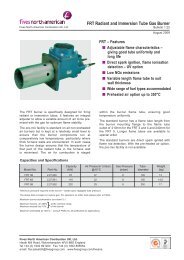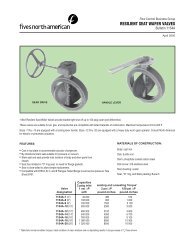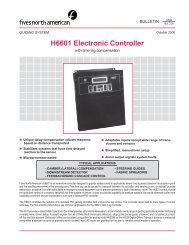LE, LEx and GLE Burner and Reaction Chamber - Fives North ...
LE, LEx and GLE Burner and Reaction Chamber - Fives North ...
LE, LEx and GLE Burner and Reaction Chamber - Fives North ...
You also want an ePaper? Increase the reach of your titles
YUMPU automatically turns print PDFs into web optimized ePapers that Google loves.
Initial Firing<br />
Note: If at any time during the fi ring cycle “steaming” is observed, hold the temperature constant until the<br />
“steaming” dissipates, then resume the remaining schedule beginning from the time the “steaming” hold<br />
began.<br />
1. Begin the dryout by lighting the burner pilot <strong>and</strong> increasing pilot gas fl ow as needed for the desired refrac-<br />
tory or hot mix temperature. If “glowing” of the pilot or its connection boss occurs during fi ring, a small fan<br />
or other air supply directed upon the hot area should be used to keep the pilot cool during extended op-<br />
eration. As temperature requirements increase, light the radial burner to increase the input.<br />
2. If temporary thermocouples cannot be installed in the reaction chamber refractory or at its exit, the pro-<br />
cess or other system temperatures may be used (with appropriate allowances for temperature losses) to<br />
infer the reaction chamber refractory temperatures. As an alternate, the burner hot mix temperature may<br />
be predicted by the overall fuel to air ratio as described previously. Remember, it is the temperature inside<br />
the reaction chamber that needs to be maintained, not an overall process temperature.<br />
3. The following time <strong>and</strong> temperature schedule is recommended :<br />
3 hour ramp from 60° F to 300° F<br />
6 hour soak at 300° F<br />
3 hour ramp from 300° F to 500° F<br />
6 hour soak at 500° F<br />
9 hour ramp to 1200° F (75° F per hour)<br />
6 hour soak at 1200° F 1<br />
8 hour ramp to 1800° F (75° F per hour)<br />
6 hour soak at 1800° F<br />
X hour ramp to operating temperature (100° F per hour) 2<br />
12 hour (minimum) cooling period from maximum temperature to ambient at a maximum of 150° F per hour<br />
unless starting production<br />
1 This soak period may be eliminated when the application does not require cyclic operation or when prefi ring<br />
will not exceed 2000° F.<br />
2 No soak period required. Note that typical <strong>LE</strong>x, <strong>LE</strong> <strong>and</strong> G<strong>LE</strong> applications are expected to operate with hot<br />
mix temperatures lower than 2800° F <strong>and</strong> the lean fuel-to-air ratio required to achieve the design maximum<br />
hot mix temperature is intended to be an operating limit for the particular system. Only exceed 2600° F<br />
after consultation with <strong>Fives</strong> <strong>North</strong> American on the specifi c operational settings for the system. In no case<br />
exceed 2800° F for St<strong>and</strong>ard Dense Castable or 3000° F for High Temperature, Low Cement Castable as<br />
damage to both burner internals <strong>and</strong> refractories may result.<br />
NOTE: Pre-fi ring refractory results in permanent linear change to the material. Cracking in both longitudinal<br />
<strong>and</strong> circumferential directions up to 3/16" wide may be observed after the chamber is cooled. When the<br />
chamber is reheated during operation, the refractory will exp<strong>and</strong>, decreasing the width of these cracks.<br />
Rapid heat <strong>and</strong> cool cycles will increase cracking <strong>and</strong> decrease the life expectancy of the refractory.<br />
Initial Firing after Optional Pre-fi re Dryout or Cold Restart<br />
Cold restart is defi ned as starting the burner system when the reaction chamber refractory is below 1000° F. The<br />
refractory is assumed to be 60° to 90° F prior to lighting.<br />
1. Light the burner <strong>and</strong> hold at low fi re.<br />
2. Increase burner fi ring rate such that the reaction chamber refractory will reach 400° F in one (1) hour. For<br />
chambers below 60° F, ramp to 400° F at a rate of 100° F per hour.<br />
3. Increase temperature set point by 300° to 400° F per hour until process temperature is achieved.<br />
WARNING: Situations dangerous to personnel <strong>and</strong> property may exist with the operation <strong>and</strong> maintenance of any combustion equipment. The presence of fuels, oxidants, hot <strong>and</strong> cold<br />
combustion products, hot surfaces, electrical power in control <strong>and</strong> ignition circuits, etc., are inherent with any combustion application. Parts of this product may exceed 160F in operation <strong>and</strong><br />
present a contact hazard. <strong>Fives</strong> <strong>North</strong> American Combustion, Inc. urges compliance with National Safety St<strong>and</strong>ards <strong>and</strong> Insurance Underwriters recommendations, <strong>and</strong> care in operation.<br />
<strong>Fives</strong> <strong>North</strong> American Combustion, Inc. - 4455 East 71st Street - Clevel<strong>and</strong>, OH 44105 USA - Phone 216.271.6000<br />
Fax 216.641.7852 - email: fna.sales@fi vesgroup.com - www.fi vesgroup.com/fi vesna<br />
Page 4<br />
4-12-4200-1







